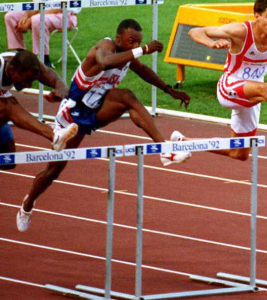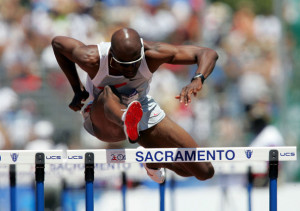The Masterful Technique of Jarrett Eaton
As a coach, I’m always looking to give my athletes guidance by pointing to hurdlers they can look to as technical models. Most of the time, the hurdlers who are at the top are the ones to point to – hurdlers like Sally Pearson, Allen Johnson, Liu Xiang, Dawn Harper-Nelson, Dayron Robles, Aries Merritt, and plenty others over the years. However, there are often other hurdlers running in the same races who are not winning, but can serve equally well as technical models. For example, Jack Pierce back in the 1990’s had the smoothest, most efficient and fluid technique I had ever seen up to that point, yet he never broke through to win a national, world, or Olympic championship. Still, if I wanted to teach my athletes any of the various aspects of technique, I would tell them to look up video of Pierce. Technically, he was a master.
[am4show not_have=’g5;’]
[/am4show][am4guest]
[/am4guest][am4show have=’g5;’]
A modern-day hurdler who has similarly impressed me, and may perhaps be on the verge of a breakthrough in 2016, is 2012 Syracuse alumnus Jarret Eaton. Eaton, who won the NCAA indoor nationals back in ’12 and who more recently won Indoor US Nationals and finished fourth at Indoor Worlds this past March, has definitely caught my eye as being the type of technician who stands out as superior to his peers, even if he isn’t defeating all of them.
Often, it takes a while for male hurdlers to really establish themselves over the 42’s, especially after transitioning from the relatively secure life of collegiate athletics to the do-what-you-can-on-your-own life of the post-collegiate athlete who has yet to secure a professional contract. Eaton, who will be 27 by the time the Olympic Trials roll around, looks like he is finally coming into his own as a hurdler. I would not be at all surprised to see him make the US team and to be a serious threat to medal at the Games in Rio.
The race that really caught my eye (because I’m not really impressed by indoor races) was Eaton’s 13.25 victory this past May in the Diamond League meet in Ostrava. Footage of the race is below:
This video reveals several things about Eaton’s technique that I like a lot. All of them go together, so I’d rather not talk about them in isolation. Overall, Eaton is fluid. There are no wasted motions, everything is moving forward, he stays in the middle of the lane, he minimizes lateral movement, his legs cycle, he maintains a forward lean between and over the hurdles, and he never looks like he is making an effort. And to me, that is what hurdling is all about – making it look effortless. How does he make it look so effortless? Let’s go ahead and break it down.
When I attended Coach Curtis Frye’s coaches’ clinic in South Carolina about 12 years ago, he emphasized the importance of keeping everything in a “tight box.” He said that you should go over a hurdle like you’re ducking through a window. To me, that means that firstly means that the arms should not be wide. The elbows should stay bent and they should stay close to the body. For male hurdlers, the elbow of the lead arm will need to open up to allow room for the trail leg to pull through, but the hand should move up and down. That’s what you’re seeing with Eaton. Meanwhile, the trail arm should lock in on the back pocket, and then punch straight back up. That’s what you’re seeing with Eaton. In that sense, he reminds me very much of Allen Johnson.
In the two photos below, you can see how similar Eaton and Johnson are in regard to their efficient arm carriage, as well as in regard to their overall technique.
Although, in these two photos, Johnson’s lead is hugging the hip better, I like how Eaton doesn’t open the elbow of the lead arm as widely, which helps with keeping the flight of the trail leg tight.
In that regard, I would say that Eaton’s legs are as efficient as his arms. I would add that his legs are so efficient because of his arms. His lead leg drives with the knee leading the way and then cycles over the hurdle. It extends on a slightly downward angle and the knee doesn’t quite lock all the way, which enables the trail leg to similarly cycle through. Also, the trail leg is active as soon as it leaves the ground. It drives upward with the knee leading the way and the heel tucked nicely under the hamstring. Most hurdlers allow their trail leg to lag, and then whip it to the front. Many coaches teach that style, but as you can see, a trail leg that keeps moving adds to that all-essential fluidity that minimizes wasted effort and thereby promotes quality technique for all ten hurdles.
As I said earlier, Eaton maintains a nice forward lean not only over the hurdles, but between the hurdles, which many hurdlers and hurdle coaches underestimate the importance of. Eaton doesn’t stand up off of hurdles. His upper body posture is never too erect.
As the video from the Ostrava meet shows, Eaton is a seven-stepper to the first hurdle, and quite an effective one. I’m neither for nor against seven-stepping, generally speaking. I say, if you’re going to do it, make sure you do it in such a way that you have the ability to transition with speed into hurdle two. The take-off distance to hurdle one has to be close enough to create speed off the hurdle. In this Ostrava race, Eaton makes an excellent transition into hurdle two; you can see him accelerating. That means his first hurdle was on point. Unfortunately, due to the camera angle, we can’t see the details of his start (the length of his first step, his take-off distance).
Another indicator of excellent technique is hip movement. The best hurdlers – the Liu Xiangs and Allen Johnsons of the world – have barely no raising of their center of mass when clearing hurdles. Their hips push forward through every hurdle. The legs go up and down but the hips push forward. And although being tall does help, height isn’t as important a factor as technical proficiency. Eaton is tall, and he has proficient technique. The hips pushing forward over the hurdles allows him to transition smoothly to the three steps between the hurdles, and to negotiate that space without smashing and crashing. As you can see in the video, he looks just as efficient over hurdle ten as he does over hurdle one.
The Ostrava race in the video represents his personal best. And no, 13.25 these days is not going to turn a lot of heads. But Eaton has traveled a long road to get where he is now. He’s dealt with injury and he’s dealt with having no contract. He has been without a coach and he has been without a consistent training group. I think he’s just now coming into his own, just now beginning to realize his potential. To me, the 13.25 indicates that something big is about to happen. I expect him to be under 13.00 by the end of 2016.
Even if he doesn’t go sub-13, Eaton represents what sound, well-executed, technically efficient hurdling looks like.
[/am4show]



